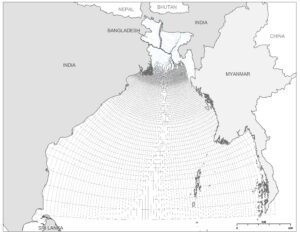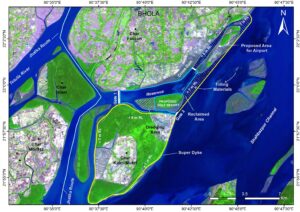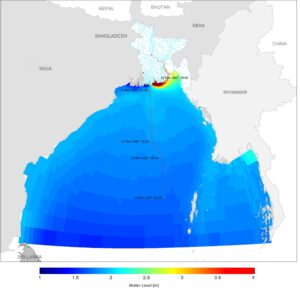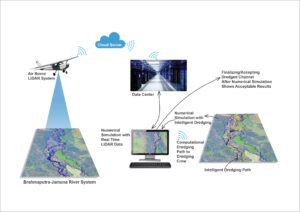by Dr. Quamrul Ahsan, Dr. Anisul Haque, Dr. Munsur Rahman, and Dr. Shampa
Introduction
The water sector of Bangladesh offers a lot of challenges as well as opportunities due to a very complex deltaic formation of the country. Among 57 transboundary rivers, three mighty river systems, the Ganges, the Brahmaputra, and the Meghna (the GBM), drain a total of 1.72 km2 watershed before they enter Bangladesh territory, an area represents only 7% of the total catchment basin. Most of Bangladesh consists of the flood plain and delta and 70% of the area is less than 1 meter above sea level, a feature that poses significant challenges due to natural hazards such as cyclonic storms and climate warming-induced sea level rise.
The annual cross border river flows entering Bangladesh territory are estimated to be 1,200 billion m3 (BCM), of which three major river systems (the GBM) contribute some 981 BCM (Mac Kirby et al., 2014). The spatial distribution of flows through the dynamically interconnected GBM systems leads to complex flow dynamics. Out of the 981 BCM, 54% is contributed by the Brahmaputra and 31% by the Ganges and 14% by the Meghna river system. The rest of the flows (1%) are contributed by other minor rivers. These dynamically interconnected river systems carrying such a big volume of flows that pose significant challenges when they confluence at Aricha and Chandpur and then finally empty into the Bay of Bengal.
The combined flow dynamics has its own dimension of complexity when the flows with significant temporal variations meet at the confluences during monsoon seasons. It is interesting to note that 85% (834 BCM) of the total transboundary flows, contributed by the GBM systems, enter the country between June and October (only 5 months) and 15% (148 BCM) flows are available during 7 months of the dry season including only 1% (11 BCM) of the flows in the dry month of February (Mac Kirby et al., 2014).
The complexity of floods becomes more intense when the peak flows from Brahmaputra (usually in mid-August) coincides with the peak flow from the Ganges (usually in mid-July) at the confluence near Aricha. A couple of examples are the devastating floods that occurred in 1988 and 1998. The coincidence of flood peaks of the Brahmaputra and the Ganges Rivers coupled with the southerly monsoon wind set-up in the Bay of Bengal were widely blamed for these devastating floods. All these three forcing mechanisms (the coincidence of two peak flows and a wind set up in the Bay of Bengal) appeared to overwhelm the drainage capacity of the river systems, resulting in devastating floods in the country.
Cyclones hitting the coastal zones are regular phenomena in Bangladesh. A severe cyclone strikes the country every three years, on average. The intensity of cyclonic storm surges as well as depth and extent of storm surge induced coastal inundation is likely to increase in changing climate through rising sea surface temperature and sea level. The Bay of Bengal is known for the active region of complex mesoscale hydrothermal features called warm-core eddies, which, when encountered by cyclones, intensify the cyclonic intensity. Cyclone Aila in 2009 is an example of this phenomenon for which the intensity of the storm went up by 43% before it made landfall (Busireddy, et al., 2019).
Riverbank erosion leads to millions of people being affected as it causes damage and loss of crops, cattle, housing structures, and farmland. The unpredictable migrating behavior of the rivers has disastrous socioeconomic effects. Coastal erosions are also common problems along the coastlines of Bangladesh. The Ganges, the Brahmaputra, and the Meghna river systems transport about a billion ton of sediment every year, part of which is contributing to land accretion. The average annual growth rate in the Meghna Estuary is about 19 km2. The present rate of the Jamuna bank erosion is about 17.70 km2 per year while bank erosion by the Padma River is about 12.98 km2 per year. The lower Meghna erodes at a rate of 29 km2 per year (BDP 2100).
Despite all these challenges, Bangladesh has made significant progress across the socio-economic spectra, in the last 48 years since independence. The GDP has grown many folds and the economy has transformed from an agrarian base to a modern manufacturing and service economy. The exceptional growth in the economy and the population and its livelihood has not only successfully leveraged the hugely abundant labor forces, fertile land and plenty of water and monsoon rains, but also has generated an increasing demand forecast for these resources. Bangladesh Delta and the Bay of Bengal offer enormous opportunities, that are mostly untapped. Economic growth along with population and their lifestyle demands more resources the Delta ecosystem can provide. Therefore, a careful and excruciating balance between the economic activities and the capacity and resilience of the ecosystem must be maintained.
An Adaptive and Integrated Approach
The Government of Bangladesh has recently approved a sweeping plan that calls for a secure, safe, resilient and prosperous Bangladesh. An adaptive delta management (ADM) practice is said to be the cornerstone of this comprehensive plan called Bangladesh Delta Plan 2100 (BDP 2100). Its primary goals are to achieve long-term food and water security while ensuring environmental sustainability along with economic growth. The plan is a robust, adaptive, and integrated strategy using a holistic approach and equitable water governance.
Adaptive and integrated approaches in implementing the Delta plan have been proposed because of the uncertainties in the forcing functions that will have an indelible impact on the Delta. Therefore a comprehensive and integrated modeling approach has been presented here, which includes not only the Ganges, the Brahmaputra, the Meghna rivers, and the Bay of Bengal but also all the inland rivers and coastal estuarine systems of the country. Different types of interventions including the coastal polders and topographical features of land are also considered in the integrated modeling framework. This integrated modeling approach is necessary to address the challenging issues presented by the water sector described earlier and it forms the basis of a delta-wide comprehensive modeling framework, called the Bangladesh Delta Model (BDM), as shown in Figure 1. An operational BDM model will emerge as a tool for adaptive delta management (ADM) to manage all the river systems and the Bay of Bengal. This tool is capable of assessing the impacts of any anthropogenic or natural interventions in the Delta and help achieve the objectives of the Blue Economy.
Bangladesh Delta Model (BDM)
The Bangladesh Delta Model (BDM) presented in this paper. The BDM model, constitutes five modules of the Delft3D modeling suite, a) hydrodynamic model, b) morphology model, c) salinity model, d) wave model and d) storm surge model. The model has been calibrated and validated during previous studies (Haque, et al., 2016, for the hydrodynamic model, WARPO and BUET, 2019, for morphology model, Akter et al., 2018 for salinity model and Al Azad et al., 2018 for storm surge model). The BDM model domain covers the entire Bangladesh, which includes all the major rivers and their flood plains, and the model domain is extended southward to the Bay of Bengal down to Sri Lanka.
Figure 1: The model domain of the BDM covers the Bangladesh Delta and the Bay of Bengal. An orthogonal curvilinear grid system discretized the domain to accurately resolve the geometric and hydro-morphological features of the Delta and the Bay of Bengal.
Harnessing the Blue Economy
To realize the full potential of the blue economy, a deep scientific understanding of the river, coastal area, the Bay of Bengal and their dynamical interactions would be extremely crucial. The BDM model has been designed to develop an understanding of the hydro-morphological dynamics of the Delta system including the Bay. The model is capable of translating the hard science into an easy to use format to formulate policy options to harness the economic opportunities the river & estuarine systems, the coastal oceans and the Bay of Bengal offer. A few examples of the model applications are given here.
Freshwater Harvesting and Land Reclamation
The Bangladesh Delta Model (BDM) is designed to formulate a plan to manage freshwater resources in the coastal areas of Bangladesh. The goal is to make fresh water available throughout the year especially during the dry season when the salinity intrusion is at its peak. The BDM is applied to assess the impact of cross-dam for building the freshwater reservoir at Char Kukri Mukri, Bhola. Considering freshwater flow from Tetulia and the Lower Meghna River, the southern tip of Bhola Island offers a favorable condition as a location to develop a freshwater reservoir (Figure 2). This one-of-a-kind effort to harvest freshwater offers a roadmap to build a reservoir at Char Kukri Mukri and will lead to further studies to explore other potential areas for additional freshwater harvesting and promote economic growth in the region.
Figure 2: Proposed Freshwater Reservoir and Land Reclamation in Char Kukri Mukri, Bhola. The freshwater reservoir and the land reclamation will help harness the Blue Economy in the region.
In addition to exploring the viability of a freshwater reservoir at Char Kukri Mukri, this study is centered-around the reclamation of land and its development to allow a continuous southward extension of Bhola. A proposed reclaimed land, an area of 9 km2, will provide infrastructural support to the tourism industry and will promote economic activities. The land can be used to build a domestic airport and a Golf resort to promote tourism in the area. The airport will serve as a connecting hub between the Char Kukri Mukri and the rest of the country. A potentially high-value property, the Golf Resort, may be developed in the char overlooking the reservoir and the West Shahbazpur Channel (Figure 2). This high-value property will add significant economic values to the region and thereby to the national GDP. The Airport and other infrastructures in the area will support the operations and economic activities of the nearby Payra Port. The prospects of leveraging the open access to sea into a major source of growth and development are also being viewed as developing the emerging blue economy of Bangladesh. The efforts made in the study are aligned with the Vision 2041 and consistent with the sustainable development goals (SDG 6, 7, 13, and 14) adopted by the UN General Assembly in 2015.
Monsoon Depression and Livelihood Support Model (MDLS) for Fishing Industry
Access to the sea provides an enormous opportunity for Bangladesh to exploit the fisheries resources in the Bay of Bengal. Marine fishing has gained growing importance in recent years and the value-addition and employment in fisheries have increased significantly. However, a sustainable fishing operation is important to maintain a balance between the exploitation and the health of the ecosystems. A policy intervention based on scientific understanding of the Bay ecosystem is necessary to regulate the fishing industry. An example of a policy intervention on banning Hilsha catch to protect the juvenile Jhatka has to turn out to be a great success for Bangladesh. However, a comprehensive study must be made to determine the size and nature of the fisheries resources in the Bay before making any policy intervention. A species-based spatial and temporal planning must be in place to achieve a sustainable goal.
In addition, the unpredictable weather systems that developed in the Bay pose serious threats to the fishing industries. It has been reported that the lack of accurate prediction of monsoon depressions and tropical cyclones developed in the Bay severely limits the ability to fish during inclement weather. Generalized warnings by the Bangladesh Meteorological Department forced the fishermen to stay away from fishing. The fishing industry has been severely affected by the warnings that turn out to be inaccurate pretty often. Therefore, an ability to accurately predict the monsoon depression and assess the associated risks may help avert overly conservative and sometimes misleading warnings.
The Bangladesh Delta Model is being configured to develop a monsoon depression and livelihood support modeling system (MDLS System) in which a process-based outcome of risk zoning for fishing and impact assessment on the marine ecosystem will be formulated. The MDLS model also provides an assessment of the fish availability and fish-catch value during an event of Monsoon Depression (MD) in the Bay. The MDLS will help design policy interventions for effective livelihood support to the fishermen in an event of a monsoon depression, to further realize the objectives of a sustainable blue economy.
The BDM model simulated wind speed, wave heights, water velocity are used to assess MD hazards. The fishermen population profiles and the boat size are considered as important model parameters used for exposure and sensitivity, respectively, to determine the risk of fishing during MD events. Fishing risks in the ocean and estuaries are being assessed by using MD hazards and fishermen exposure and sensitivity at district levels. The assessment-based warning at district levels should be more effective and consistent and it is highly recommended that the Bangladesh Meteorological Department use this outcome-based effective warning for any MD develops in the Bay.
The Bay of Bengal and the Storm Surge Forecasting System
While Bangladesh is blessed with the bounty of natural resources like the Bay of Bengal, it is also highly vulnerable to natural hazards. It has a long history of resilience and capacity of coping with major natural disasters. The government and the people have a wealth of experience in preparing for and responding to, disaster events. Bangladesh has been increasingly respected and recognized as a leader in adopting a more holistic approach to risk reduction.
Being a world leader in developing comprehensive planning and implementing operational disaster management, Bangladesh needs to focus on capacity building on tidal (astronomical, meteorological, and tsunami) forecast modeling and research. The Bangladesh Delta Model has provided such capability, which could be a part of a multi-agency program to produce a sustainable and comprehensive tidal and storm surge forecasting modeling and observing system. The system will function both as an operational and research tool to be used not only to support adaptation to natural hazards and disaster risk reduction but also to foster sustained economic growth with managed environmental, infrastructural, and economic resources of the coastal areas and the Bay of Bengal.
Figure 3: The BDM model simulated Storm Surge for Cyclone SIDR which made landfall on Nov 15, 2007.
A key to the program is communicating the results of the forecasting model to the officials and decision-makers involved in disaster and risk management. The system will also share scientific results and resources with other Governmental agencies such as the Prime Minister’s Office (PMO), Ministry of Water Resources (BWDB), Ministry of Fisheries and Livestock, Ministry of Shipping, Ministry of Disaster Management and Relief, Ministry of Environment and Forest, Ministry of Foreign Affairs and Meteorological Department.
The storm surge forecasting system would be the portal to disseminate the flood and surge information. It is envisioned that an automated text messaging system will send alerts to appropriate authorities when the predetermined location(s) in coastal regions are forecasted to exceed a flood depth threshold. The text message alert will direct the receiver to visual GIS flood depth layers supported by actual elevation data specific to each coastal zone. The GIS layers of the forecast will be available 72 hours, 48 hours, 36 hours, 24 hours, 12 hours, and 6 hours prior to surge impact. The forecasts will also continue to be displayed on the Government websites and large LED display screens hosted in Prime Ministers Office, relevant Ministries and Governmental Agencies directly involved in a natural disaster and risk management. The forecasting system presented here will add values to the existing forecasting system by BMD. Figure 3 illustrates the BDM simulated storm surge for cyclone SIDR that hit Bangladesh coasts in November 2007.
This system can also be used as a modeling and research tool to investigate the social and economic impact of global warming in the coastal regions of Bangladesh. The modeling tool would be useful to address and mitigate various coastal issues, such as, increase drainage capacity and reduce floods, waterlogging, salinity intrusions, riverbank, and coastal erosions, reclaim new lands and waterway transport. Scientists and engineers in academic and Governmental and non-Governmental sectors will have a scientific edge to address short-term and long-term hydro-meteorological, climatological, social, economic, and geopolitical challenges. The scientific and technical capabilities will allow Bangladesh to effectively formulate its maritime strategy and gain upper hand in projecting its interest in the highly contested and strategically important Bay of Bengal.
Marine and Inland Water Transport and Intelligent Dredging
The Bay of Bengal has fueled the development and economic growths in the region for centuries. It provided a maritime transportation system that facilitated the efficient movement of goods and commodities, supporting a cluster of industries such as manufacturing, shipbuilding, agribusiness, commercial fishing, and energy exploration. Bangladesh being a riverine country, it offers a significant comparative advantage in inland water transport. The country is crisscrossed by a network of about 24,000 km. of rivers, streams, and canals.
The open access to the sea is a significant advantage to Bangladesh. Although the port facilities that could serve the growing domestic trades and commerce, it may also become a regional hub for marine transportation. Bangladesh is slowly capitalizing on the open access to the sea by establishing new ports, in addition to Chittagong and Mongla ports. The ongoing Payra port construction in Patuakhali is an example. There are many other opportunities that could boost Bangladesh trade and commerce by reducing the cost of trade logistics through easier and lower-cost access to ports in terms of time and money.
Marine Spatial Planning is an important element in making a plan to exploit the resources in the Bay of Bengal. The Bangladesh Delta Model can be a useful tool to develop spatial planning based on the hydrodynamic and morphological and other environmental characteristics of the coastal and oceanic environment. The BDM model is capable of providing solutions to the balancing act between the economic activities and capacity and the resilience of the marine ecosystem. For example, the modeling simulations under different atmospheric and climatic conditions, in the coastal area can identify the area feasible for port development, identify the shipping route so that it doesn’t conflict with the fisheries exploitation and other economic activities while maintaining a sustainable ecosystem.
There is 14 core waterways network recommended in the IWT Master Plan, 2009 that covers altogether 1,822 km of waterways. The waterways linking two maritime ports (Chittagong and Mongla) and river ports Dhaka-Narayanganj area and routes under Bangladesh-India Protocol on IWT28 were marked as the highest priority routes. Dredging and maintaining river navigability can be expensive and the development of river navigability for transportation purposes must weigh the relative costs and benefits.
The BDM model is being configured and updated using the real-time draft data collected by the LiDAR technology. A computer algorithm is being developed to analyze the LiDAR generated high-resolution topographic and bathymetric data to produce dredging pathways along the river that will be configured into the modeling system. A series of iterative modeling exercises will be performed in order to determine optimized dredging paths that will maximize the conveyance capacity and produce a managed river system that will provide enough draft for ships to navigate. After the optimized dredging paths are determined, the model will generate a detailed channel configuration including cross-sectional geometry and GPS coordinates of the dredging alignments in order to support field crews to dredge the riverbed with surgical precision and allow the ships to navigate through river freely.
Figure 4: The BDM is being configured with a one-of-a-kind methodology, called Intelligent Dredging (ID), which will be applied in managing complex river systems to maintain the navigability of the waterways. The Intelligent Dredging (ID) is the dredging of active and silted channels aided by modeling simulations and real-time bathymetric data using LiDAR technology. An operational BDM model incorporates real-time data and generates computational dredging pathways to determine effective dredging channels using model simulations. These computational dredging channels provide the mapping coordinates of the dredging alignments in order to support field crews to dredge the riverbed with surgical precision and allow the ships to navigate through the rivers freely.
Conclusions
The water sector of Bangladesh offers a lot of challenges as well as opportunities due to a very complex deltaic formation of the country. Too much water (85% of total) in the monsoon months and too little water (15%) in dry seasons, pose serious threats to the socio-economic development of the country. However, the rich and vibrant Delta ecosystem continues to generate enormous services that support over 160 million people. While Bangladesh is blessed with the bounty of natural resources, such as fertile lands, rivers, and the Bay of Bengal, it is also highly vulnerable to anthropogenic and natural hazards. It has a long history of resilience and capacity of coping with major natural disasters and has been increasingly respected and recognized in the world in managing the risks.
Bangladesh recognizes the need for intelligent management of its water resources, and hence unveiled a sweeping plan, Bangladesh Delta Plan 2100, that calls for a secure, safe, resilient and prosperous Bangladesh. Its primary goals are to achieve long-term food and water security while ensuring environmental sustainability along with economic growth. The present paper has offered an integrated mathematical model that covers all the rivers and estuaries of the country and the Bay of Bengal. The mathematical model, called the Bangladesh Delta Model (BDM) will serve as a tool for adaptive delta management outlined in the Bangladesh Delta Plan 2100. This tool also offers a scientific edge to address short-term and long-term hydro-meteorological, morphological, climatological, social, economical and geopolitical challenges. The scientific and technical capabilities will allow Bangladesh to effectively formulate its maritime strategy and gain upper hand in projecting its interest in the highly contested and strategically important Bay of Bengal.




